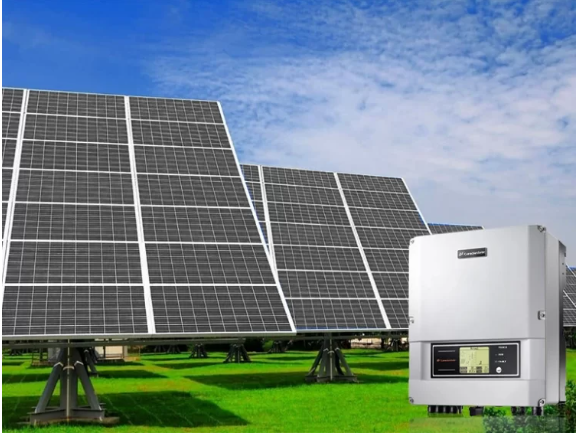
As the world moves toward more sustainable energy sources, solar power is increasingly seen as a reliable and eco-friendly solution. At the heart of every solar energy system, however, lies an often-overlooked but essential component: the solar inverter. This device plays a critical role in converting the electricity generated by solar panels into a form that is usable for homes, businesses, and grids.
In this article, we’ll explore what solar inverters are, how they function, the different types available, and their importance in ensuring the optimal performance of a solar power system.
What is a Solar Inverter?
A solar inverter is an electrical device that converts the direct current (DC) electricity produced by solar panels into alternating current (AC) electricity. The reason this conversion is necessary is that most electrical appliances, from light bulbs to refrigerators, run on AC power. While solar panels generate DC electricity when exposed to sunlight, it’s the AC form that can be used by these appliances.
Additionally, solar inverters have several other important functions, including maximizing energy production, managing battery storage (in hybrid systems), and ensuring safety by monitoring system performance and grid connection.
How Does a Solar Inverter Work?
The process of converting DC electricity to AC power is a critical step in the operation of a solar power system. Here’s a simplified breakdown of how a solar inverter works:
- DC to AC Conversion: When sunlight hits the solar panels, it excites the electrons in the photovoltaic cells, generating DC electricity. This electricity is then sent to the solar inverter. The inverter converts the DC into AC by using electronic components like transistors and diodes to manipulate the flow of electricity.
- Maximum Power Point Tracking (MPPT): Solar inverters are equipped with MPPT technology, which continuously adjusts the electrical operating point of the solar panels to extract the maximum possible power. MPPT ensures that the solar system is working at its highest efficiency, even as environmental conditions change throughout the day.
- Grid Synchronization: In grid-tied solar systems, the inverter synchronizes the AC power with the grid’s voltage, frequency, and phase. This allows any excess energy produced by the solar panels to flow back into the grid, often allowing homeowners to receive credits through net metering programs.
- Safety Features: Modern inverters also include various safety features, such as overcurrent protection, grounding, anti-islanding protection, and temperature monitoring. These safeguards ensure that the system operates within safe parameters, preventing damage to the inverter or other components.
Types of Solar Inverters
Solar inverters come in various types, each with its own advantages and disadvantages. Choosing the right type of inverter is crucial for maximizing the performance and efficiency of your solar power system. Let’s take a look at the main types of solar inverters available:
1. String Inverters
The most common type of solar inverter is the string inverter. In this system, multiple solar panels are connected in series, forming a “string.” The DC electricity from the panels in the string is sent to a single central inverter, which converts it to AC power.
- Advantages:
- Simple design and installation.
- Cost-effective for small to medium-sized systems.
- Well-suited for installations where the panels receive similar amounts of sunlight.
- Disadvantages:
- If one panel in the string is shaded or underperforming, it can reduce the overall performance of the entire string.
- Limited flexibility if panels are spread across multiple roof sections with varying amounts of sunlight.
2. Microinverters
Unlike string inverters, microinverters are installed on each individual solar panel. Each microinverter converts the DC electricity produced by its respective panel into AC power.
- Advantages:
- Each panel operates independently, so shading or performance issues on one panel do not affect the others.
- Improved energy production and efficiency, especially in installations with varied shading or orientations.
- Allows for monitoring and optimizing performance of individual panels.
- Disadvantages:
- More expensive than string inverters, both in terms of the initial cost and the complexity of installation.
- Requires more maintenance due to the larger number of individual units.
3. Power Optimizers
Power optimizers are similar to microinverters but with a key difference: instead of converting DC power to AC, power optimizers simply optimize the DC power before sending it to a central string inverter for conversion.
- Advantages:
- Improves system efficiency by optimizing the performance of individual panels.
- Lower cost compared to microinverters, while still offering many of the same benefits.
- Provides monitoring capabilities for individual panels, similar to microinverters.
- Disadvantages:
- Requires the use of a central string inverter, so it doesn’t offer the complete independence that microinverters do.
- Slightly more expensive than traditional string inverters.
4. Hybrid Inverters
Hybrid inverters are designed for systems that incorporate both solar power and battery storage. These inverters can manage both the solar energy generation and the charging/discharging of batteries, providing a more integrated energy management solution.
- Advantages:
- Allows for energy storage, which is useful for off-grid applications or for systems designed for energy independence.
- Can be more cost-effective than installing separate inverters and battery management systems.
- Ideal for use in regions with frequent power outages or in off-grid applications.
- Disadvantages:
- More expensive than traditional inverters due to the added functionality.
- Installation and setup can be more complex.
Why Solar Inverters are Important
Solar inverters are integral to the efficient operation of any solar energy system. Here’s why they matter:
- Maximizing Energy Production: Solar inverters ensure that the maximum amount of energy is extracted from the solar panels. Through features like MPPT, they optimize the efficiency of the system and ensure that every ray of sunlight is converted into usable electricity.
- Converting DC to AC: Since most household appliances run on AC power, the inverter makes it possible for the electricity generated by solar panels to be used directly. Without the inverter, the DC power generated by the panels would be unusable.
- Monitoring System Performance: Many modern inverters come with built-in monitoring features that allow users to track the performance of their system in real time. This enables homeowners to detect issues early, potentially reducing the cost of repairs and maintenance.
- Grid Integration: For grid-tied solar systems, the inverter plays a key role in syncing the power produced by the panels with the utility grid. It also ensures that any excess electricity is fed back into the grid in accordance with local regulations, allowing users to take advantage of net metering programs.
- Safety and Protection: Inverters are equipped with safety features to protect both the system and the grid from electrical faults. For example, anti-islanding technology ensures that the inverter disconnects from the grid in the event of a power outage, preventing dangerous situations for utility workers.
Conclusion
The solar inverter may not be the most visible part of a solar energy system, but it is undoubtedly one of the most important. By converting DC electricity into usable AC power, maximizing energy efficiency, and ensuring safety and reliability, solar inverters enable solar systems to perform at their best.
Whether you are installing a small residential system or a large commercial array, choosing the right inverter for your needs is essential. With options ranging from traditional string inverters to more advanced microinverters and hybrid inverters, there is a solution for almost every type of installation. Understanding the different types of inverters and how they function will help you make an informed decision, ensuring that your solar energy system performs efficiently and reliably for years to come.



